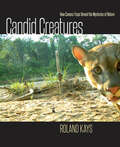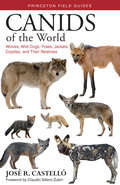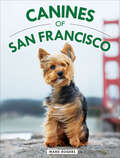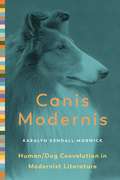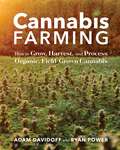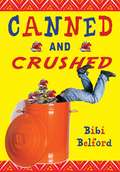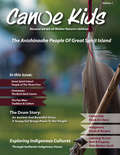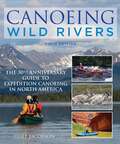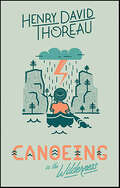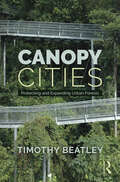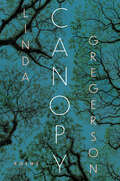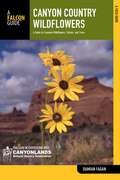- Table View
- List View
Canadians and the Natural Environment to the Twenty-First Century
by Neil S ForkeyCanadians and the Natural Environment to the Twenty-First Century provides an ideal foundation for undergraduates and general readers on the history of Canada's complex environmental issues. Through clear, easy-to-understand case studies, Neil Forkey integrates the ongoing interplay of humans and the natural world into national, continental, and global contexts.Forkey's engaging survey addresses significant episodes from across the country over the past four hundred years: the classification of Canada's environments by its earliest inhabitants, the relationship between science and sentiment in the Victorian era, the shift towards conservation and preservation of resources in the early twentieth century, and the rise of environmentalism and issues involving First Nations at the end of the century. Canadians and the Natural Environment to the Twenty-First Century provides an accessible synthesis of the most important recent work in the field, making it a truly state-of-the-art contribution to Canadian environmental history.
Cancer Hazards: The 2015 IARC Classifications: Implications for Regulation, Environmental Justice, and Global Health (AESS Interdisciplinary Environmental Studies and Sciences Series)
by Martha RichmondThis book focuses on a monograph published in 2017 by the International Agency for Research on Cancer (IARC), an agency of the World Health Organization (WHO), discussing its carcinogen hazard classification of four pesticides: parathion, malathion, diazinon, and tetrachlorvinphos as well as the herbicide glyphosate. The monograph provided a detailed discussion of considerations and conclusions made by a group of experts who met in 2015 to evaluate these compounds. Although not universally true, many of these substances, from the time of their commercial introduction to their present-day use, have spread significantly in the environment, affecting animals and plants in the larger ecosystem, the overall health of the environment, and human health. This book develops each of these issues before turning to the IARC review process, both the general process and its evolution over time, and compound selection criteria and deliberations regarding the substances discussed in the 2017 monograph. Final book sections detail scientific and private sector reactions to and implications of the IARC classifications. Hazard identification is contrasted with various models of quantitative risk assessment. The last chapters highlight the importance of hazard identification for members of domestic and global underserved communities involved in farming and landscape work, where exposures may vary widely, are not well-regulated, and where health outcomes are often not carefully documented.
Candid Creatures: How Camera Traps Reveal the Mysteries of Nature
by Roland KaysA riveting collection of photographs that captures wild animals in their native habitats.In Candid Creatures, the first major book to reveal the secret lives of animals through motion-sensitive game cameras, biologist Roland Kays has assembled over 600 remarkable photographs. Drawing from archives of millions of color and night-vision photographs collected by hundreds of researchers, Kays has selected images that show the unique perspectives of wildlife from throughout the world. Using these photos, he tells the stories of scientific discoveries that camera traps have enabled, such as living proof of species thought to have been extinct and details of predator-prey interactions.Each image captures a moment frozen in the camera’s flash as animals move through their wild habitats. Kays also discusses how scientists use camera traps to address conservation issues, creating solutions that allow humans and wild animals to coexist. More than just a collection of amazing animal pictures, the book’s text, maps, and illustrations work together to describe the latest findings in the fast-moving field of wildlife research. Candid Creatures is a testament to how the explosion of game cameras around the world has revolutionized the study of animal ecology. The powerful combination of pictures and stories of discovery will fascinate anyone interested in science, nature, wildlife biology, or photography.
Candid Creatures: How Camera Traps Reveal the Mysteries of Nature
by Roland KaysA riveting collection of photographs capturing wild animals in their native habitats and demonstrating the importance of camera traps.In Candid Creatures, the first major book to reveal the secret lives of animals through motion-sensitive game cameras, biologist Roland Kays has assembled over 600remarkable photographs. Drawing from archives of millions of color and night-vision photographs collected by hundreds of researchers, Kays has selected images that show the unique perspectives of wildlife from throughout the world. Using these photos, he tells the stories of scientific discoveries that camera traps have enabled, such as living proof of species thought to have been extinct and details of predator-prey interactions.Each image captures a moment frozen in the camera’s flash as animals move through their wild habitats. Kays also discusses how scientists use camera traps to address conservation issues, creating solutions that allow humans and wild animals to coexist. More than just a collection of amazing animal pictures, the book’s text, maps, and illustrations work together to describe the latest findings in the fast-moving field of wildlife research.Candid Creatures is a testament to how the explosion of game cameras around the world has revolutionized the study of animal ecology. The powerful combination of pictures and stories of discovery will fascinate anyone interested in science, nature, wildlife biology, or photography.“Full of fabulous pictures of weird and wonderful creatures . . . [Candid Creatures is] loaded with information and carries a strong conservation message.” —Conservation Biology
Cane Toads and Other Rogue Species: Participant Second Book Project
by Participant Productions edited by Karl WeberWhat does an unusually large, ugly, invasive species of toad have to do with global warming, international trade, and the survival of biodiversity? Quite a lot, actually. Mark Lewis's amazing and hilarious documentary Cane Toads tells the story of Bufo marinus, which was introduced to Australia in 1935 to control bugs but which quickly became a far greater menace than the beetles they eat. Today they number in the hundreds of millions and are taking over Australian habitats at 25 miles per year, spreading disease and killing native species as they go. Rogue Species explains the little-understood dangers of invasive species. Ranging from the zebra mussel (currently threatening the health of the Great Lakes) to the infamous kudzu vine (a Japanese import that now smothers seven million acres in the American southeast), these disastrous human blunders threaten the biodiversity on which all life-including our own-depends. The book will raise readers' awareness about the threat of non-native species, increase their appreciation of natural biodiversity, and explain what they can do to help protect unique ecosystems wherever they live or travel.
Canids of the World: Wolves, Wild Dogs, Foxes, Jackals, Coyotes, and Their Relatives (Princeton Field Guides)
by José R. Castelló Claudio Sillero-ZubiriThe most complete and user-friendly photographic field guide to the world’s canids <P><P>This stunningly illustrated and easy-to-use field guide covers every species of the world’s canids, from the Gray Wolf of North America to the dholes of Asia, from African jackals to the South American Bush Dog. <P><P> It features more than 150 superb color plates depicting every kind of canid and detailed facing-page species accounts that describe key identification features, morphology, distribution, subspeciation, habitat, and conservation status in the wild. The book also includes distribution maps and tips on where to observe each species, making Canids of the World the most comprehensive and user-friendly guide to these intriguing and spectacular mammals.Covers every species and subspecies of canid <br>Features more than 150 color plates with more than 600 photos from around the globe <br>Depicts species in similar poses for quick and easy comparisons <br>Describes key identification features, habitat, behavior, reproduction, and much more <br>Draws on the latest taxonomic research <br>Includes distribution maps and tips on where to observe each species <br>The ideal field companion and a delight for armchair naturalists
Canines of London
by Bridget DaveyA joyful celebration of London’s vibrant dog community, Canines of London collects close to 300 engaging photos taken throughout neighborhoods and parks within this eclectic, dog-loving city. From English Bulldogs to Welsh Corgis, Golden Retrievers to Dachshunds, London is full of dogs and the people who love them. In Canines of London, dog photographer Bridget Davey gathers up close to 300 photos taken all around one of world's great dog-loving cities. Gaze upon delightful pups living large beside Buckingham Palace, the London Eye, Piccadilly Circus, and more. No London landmark is left unvisited, and no dog left unphotographed. The follow up to Weldon Owen’s Canines of New York and Canines of San Francisco, this is the perfect gift for dog lovers everywhere. DIVERSE BREEDS AND ICONIC LOCATIONS: Includes over 300 utterly delightful photographs of dogs out and about in London, from Big Ben to the London Eye to the local pub, plus captions that give cute details of each dog's personality. Sure to delight dog lovers everywhere. PERFECT FOR ANGLOPHILES: London is a world-class city beloved by those both in and out of the UK. it's also the most popular tourist destination in the world, attracting over 30 million international visitors every year. LATEST IN A SUCCESSFUL SERIES: Weldon Owen’s Canines of New York and Canines of San Francisco have pleased dog lovers across the world, and London is sure to be the most amazing dog destination yet.
Canines of New York (Canines Ser.)
by Heather WestonHundreds of photographs that “capture the essence and the heart of these wonderful creatures in glorious settings” (Julie Klam, New York Times-bestselling author).A visual celebration, Canines of New York collects more than three-hundred photographs taken by acclaimed Brooklyn-based photographer Heather Weston throughout the five boroughs of this incredible, dog-loving city. Featuring pups in every part of the Big Apple, from iconic landmarks to their owners’ brownstone steps, this is the perfect gift for every dog lover.“Weston’s love of both dogs and New York City shines in every funny, gorgeous photograph. She captures the special brightness dogs bring to big-city life, from the Bronx to the Battery and in every borough.” —E. Lockhart, #1 New York Times-bestselling author of We Were Liars“Whether it’s a Brooklyn pupster, a Bronx Bulldog, a canine commuter on the Staten Island Ferry or a group of buddies meeting at a Soho dog park, photographer Heather Weston perfectly captures what it means to be a dog in the City That Never Sleeps.” —Dogster“The perfect book to showcase some of New York City’s furry friends . . . displays practical, pompous, and pretty pooches like never before.” —Broadway World
Canines of San Francisco
by Mark RogersA joyful celebration of the canine community throughout every neighborhood in this passionate, dog-loving city from the acclaimed Bay Area photographer. In this book featuring some 300 photographs of the dogs that call The City by the Bay their home, acclaimed Bay Area and dog rescue photographer Mark Rogers has a unique talent for capturing each dog’s individual personality, as tiny puppies dominate even the most iconic landmarks. From the Golden Gate Bridge to Haight-Ashbury, from Alcatraz to the Embarcadero, this book is an adorable tribute to the city’s most fetching four-legged inhabitants.
Canis Modernis: Human/Dog Coevolution in Modernist Literature (Animalibus)
by Karalyn Kendall-MorwickModernist literature might well be accused of going to the dogs. From the strays wandering the streets of Dublin in James Joyce’s Ulysses to the highbred canine subject of Virginia Woolf’s Flush, dogs populate a range of modernist texts. In many ways, the dog in the late nineteenth and early twentieth centuries became a potent symbol of the modern condition—facing, like the human species, the problem of adapting to modernizing forces that relentlessly outpaced it. Yet the dog in literary modernism does not function as a stand-in for the human. In this book, Karalyn Kendall-Morwick examines the human-dog relationship in modernist works by Virginia Woolf, Jack London, Albert Payson Terhune, J. R. Ackerley, and Samuel Beckett, among others. Drawing from the evolutionary theories of Charles Darwin and the scientific, literary, and philosophical work of Donna Haraway, Temple Grandin, and Carrie Rohman, she makes a case for the dog as a coevolutionary and coadapting partner of humans. As our coevolutionary partners, dogs destabilize the human: not the autonomous, self-transparent subject of Western humanism, the human is instead contingent, shaped by its material interactions with other species. By demonstrating how modernist representations of dogs ultimately mongrelize the human, this book reveals dogs’ status both as instigators of the crisis of the modern subject and as partners uniquely positioned to help humans adapt to the turbulent forces of modernization.Accessibly written and convincingly argued, this study shows how dogs challenge the autonomy of the human subject and the humanistic underpinnings of traditional literary forms. It will find favor with students and scholars of modernist literature and animal studies.
Canis Modernis: Human/Dog Coevolution in Modernist Literature (Animalibus: Of Animals and Cultures #19)
by Karalyn Kendall-MorwickModernist literature might well be accused of going to the dogs. From the strays wandering the streets of Dublin in James Joyce’s Ulysses to the highbred canine subject of Virginia Woolf’s Flush, dogs populate a range of modernist texts. In many ways, the dog in the late nineteenth and early twentieth centuries became a potent symbol of the modern condition—facing, like the human species, the problem of adapting to modernizing forces that relentlessly outpaced it. Yet the dog in literary modernism does not function as a stand-in for the human. In this book, Karalyn Kendall-Morwick examines the human-dog relationship in modernist works by Virginia Woolf, Jack London, Albert Payson Terhune, J. R. Ackerley, and Samuel Beckett, among others. Drawing from the evolutionary theories of Charles Darwin and the scientific, literary, and philosophical work of Donna Haraway, Temple Grandin, and Carrie Rohman, she makes a case for the dog as a coevolutionary and coadapting partner of humans. As our coevolutionary partners, dogs destabilize the human: not the autonomous, self-transparent subject of Western humanism, the human is instead contingent, shaped by its material interactions with other species. By demonstrating how modernist representations of dogs ultimately mongrelize the human, this book reveals dogs’ status both as instigators of the crisis of the modern subject and as partners uniquely positioned to help humans adapt to the turbulent forces of modernization.Accessibly written and convincingly argued, this study shows how dogs challenge the autonomy of the human subject and the humanistic underpinnings of traditional literary forms. It will find favor with students and scholars of modernist literature and animal studies.
Cannabis Farming: How to Grow, Harvest, and Process Organic, Field-Grown Cannabis
by Adam Davidoff Ryan PowerStart your own organic cannabis farm with this complete how-to manual written by two farmers with a decade of experience growing cannabis in the field. Cannabis is rapidly being decriminalized across the country, causing a surge in consumer demand and enabling growers to cultivate cannabis in the open, rather than secretly in greenhouses. Whether you&’re a small-scale vegetable farmer who wants to add a high-value crop or a home cannabis grower who wants to expand their operation, authors Adam Davidoff and Ryan Power can help you get growing. They were some of the first vegetable farmers in California to start growing cannabis as a field crop, and have even developed their own cannabis strains that are adapted to field growing rather than indoor cultivation. Now is the perfect time to start growing cannabis for profit!
Canned and Crushed
by Bibi BelfordWhen Sandro Zapote finds out his little sister needs heart surgery, he is determined to help his parents raise the money they’ll need to help her get better. Sandro’s dad is in the states illegally and must work two jobs to support the family. For one, he picks up roadkill for the department of streets and sanitation and gets paid by the carcass. For the other, he collects scrap metal to recycle for cash. Sandro helps his dad with some of the scrap metal heavy lifting, and one headboard, a weight bench, some gutters, and a few car parts later, Sandro has a brilliant idea: can collecting. Save the environment. Save his family. Maybe even save some spending money for the fabulous, fast new bike he’s been coveting. Well-meaning and with funny inner monologue, Sandro is the kind of person you can’t help but cheer for. He’s a boy who loves drawing, soccer, and his little sister. And whether he’s fishing a fuzzy, dust-coated turtle out from under his sister’s bed or organizing a school-wide can drive all by himself, Sandro is a smart, self-aware hero, who makes just a few mistakes along the way. Canned and Crushed, by first-time author Bibi, gives Sandro a funny, relatable, readable voice, while being fresh and original. It’s a story that will open its readers’ eyes, dealing with issues of illegal immigration, unemployment, racism and religious persecution, bullying, and more--carefully and with a light and often humorous touch. This is a cross between The Absolutely True Diary of a Part-Time Indian and Diary of a Wimpy Kid, and it’s a book no kid will want to miss.
Canoe Kids Volume 1: The Anishinnabe (Ojibwe) Peoples of Great Spirit Island
by The communities of Manitoulin Island Canoe KidsCanoe Kids is a book that we hope you will keep. The information, stories and pictures are timeless and will never feel old. The stories are already thousands of years old and they are as relevant now (perhaps more so) than ever before. As your collection grows each new and old edition can be enjoyed, re-read and shared by new and old family members and acquaintances. Our team doesn't just travel and spend a few days in each location. We spend months on location and build real relationships. That means that the materials you read are not only the result of exhaustive work but also of the care and closeness of the friendships made within the community by the Canoe Kids staff. This, we believe, is much more than just reporting. This is our mission and lives too, and we are thrilled to have you join us on our journeys.
Canoeing & Kayaking Georgia 2e
by Bob Sehlinger Suzanne WelanderCovering thousands of miles of Georgia's waterways, Canoeing & Kayaking Georgia is the definitive guide to Georgia's whitewater to wilderness swamps -- and everything in between.
Canoeing Wild Rivers: The 30th Anniversary Guide to Expedition Canoeing in North America (How to Paddle Series)
by Cliff JacobsonThe 30th Anniversary Edition of the classic Expedition Canoeinghas long been considered the premier guide to canoeing and exploring North America's waterways. This thirtieth-anniversary edition expertly details everything you need to know about paddling the continent's wild rivers.Outdoors writer and wilderness canoe guide Cliff Jacobson draws on his thirty-plus years of river running to give you sound advice, fresh new ideas, and advanced techniques for canoeing in the wilderness. Completely updated and revised, inside you'll find dozens of full-color photos, how-to illustrations, source charts, canoeing and camping tricks, a chapter full of hard-won advice from more than twenty-five of Jacobson's fellow canoeing experts, and a brand new chapter devoted to paddling desert and swamp rivers.Look inside to find:How to pick a crewRoute and trip planningCanoeing and camping gearNavigating by map, compass, and GPSHow to deal with dangerous bearsCanoe hazards and rescueBarren-land travelPreparation and skills are everything when canoeing wild rivers. Take along this guide on all of your canoeing adventures.
Canoeing in the Wilderness
by Henry David ThoreauThoreau’s famous trip through the Maine Woods reissued to entertain, encourage, and inspire contemporary naturalists. Thoreau paints the woods and waterways of Maine with the same loving hand that described his Walden home, and entertains with the successes and difficulties of the trip and the quirks of his companion and their guide, Joseph Polis, told with a wit and insight that can only be found in Thoreau.
Canoeing the Boundary Waters
by Marion StresauThe Account of One Family's Explorations in the Boundary Waters Canoe Area.
Canoeing with José
by Jon LurieThe first time journalist Jon Lurie meets José Perez, the smart, angry, fifteen-year-old Lakota-Puerto Rican draws blood. Five years later, both men are floundering. Lurie, now in his thirties, is newly divorced, depressed, and self-medicating. José is embedded in a haze of women and street feuds. Both lack a meaningful connection to their cultural roots: Lurie feels an absence of identity as the son of a Holocaust survivor who is reluctant to talk about her experience, and for José, communal history has been obliterated by centuries of oppression.Then Lurie hits upon a plan to save them. After years of admiring the journey described in Eric Arnold Sevareid&’s 1935 classic account, Canoeing with the Cree, Lurie invites José to join him in retracing Sevareid&’s route and embarking on a mythic two thousand-mile paddle from Breckenridge, Minnesota, to the Hudson Bay.Faced with plagues of mosquitoes, extreme weather, suspicious law enforcement officers, tricky border crossings, and José&’s preference for Kanye West over the great outdoors, the journey becomes an odyssey of self-discovery. Acknowledging the erased native histories that Sevareid&’s prejudicial account could not perceive, and written in gritty, honest prose, Canoeing with José is a remarkable journey.
Canoeing with the Cree
by Eric SevareidIn 1930 two novice paddlers--Eric Sevareid and Walter C. Port--launched a secondhand 18-foot canvas canoe into the Minnesota River at Fort Snelling for an ambitious summer-long journey from Minneapolis to Hudson Bay. Without benefit of radio, motor, or good maps, the teenagers made their way over 2,250 miles of rivers, lakes, and difficult portages. Nearly four months later, after shooting hundreds of sets of rapids and surviving exceedingly bad conditions and even worse advice, the ragged, hungry adventurers arrived in York Factory on Hudson Bay--with winter freeze-up on their heels. First published in 1935, Canoeing with the Cree is Sevareid's classic account of this youthful odyssey. The newspaper stories that Sevareid wrote on this trip launched his distinguished journalism career, which included more than a decade as a television correspondent and commentator on the CBS Evening News.
Canoeing: Paddling Basics
by Cecil KuhneIncludes: Elements and construction of the canoe; Determining the appropriate canoe for different water types; Recognizing and navigating river hazards and rapids; Planning and equipping day and overnight trips; Basic and advanced, solo and tandem paddling techniques; Safety and rescue procedures.
Canopy Cities: Protecting and Expanding Urban Forests
by Timothy BeatleyThis book provides a comprehensive overview of the essential role of trees and forests in cities and examines the creative approaches cities around the world are taking to protect trees and expand their urban forests. Moving beyond the view that trees are luxuries and therefore non-essential to the life of a city, the book examines urban tree policies and approaches that foster tree protection, including tree codes and bylaws, and calls for greater community engagement to preserve this important facet of urban life. Through an international range of examples and case studies, featuring cities in the United States, Canada, Singapore, the Netherlands, Australia, France, New Zealand, Mexico, Sierra Leone, and the United Kingdom. The book offers best practice examples where trees have been further integrated into the fabric of urban planning and design, including forested towers, interior rainforests, tiny urban forests, and metropolitan forests. Written by a leading authority in the field, this is a fascinating read for researchers, students, and practitioners in urban planning, landscape architecture, and environmental policy and planning.
Canopy: Poems
by Linda GregersonA long-awaited yet startlingly urgent new collection from &“a contemporary master&”*—a fierce, big-hearted eye on our last, tumultuous decade, and our fragile environment *Los Angeles Review of Books Linda Gregerson&’s long-awaited new collection is a tour de force, a compendium of lives touched by the radical fragility of the planet and, ultimately, the endless astonishment and paradox of being human within the larger ecosystem, &“in a world where every breath I take is luck.&” From the Syrian refugee and ecological crises, to police brutality and COVID, to the Global Seed Vault buried under permafrost, the poems ask: How does consciousness relate to the individual body, the individual to the communal, the community to our environment? How do we mourn a loved one, and how do we mourn strangers? The magnificent poems in Canopy catalogue and reckon with humanity and the natural world, mortality, rage, love, grief, and survival.
Canyon Country Wildflowers: A Guide to Common Wildflowers, Shrubs, and Trees (Wildflower Series)
by Damian FaganThis easy-to-use guide features: a tough, water-resistant cover and extra-durable binding, made to withstand vigorous field use; detailed descriptions and color photos of more than 200 plants; an introduction to the habitats and ecology the Canyonlands region; a primer on plant characteristics; and a glossary of botanical terms.
Canyon Sacrifice
by Scott Graham"This riveting series debut showcases Graham's love of nature and archeology, simultaneously interjecting some serious excitement. Graham is to be commended for weaving together several cultures into one story. Recommend to readers who enjoy Tony Hillerman, Nevada Barr, and C.J. Box's Joe Pickett series."-LIBRARY JOURNAL"A gripping tale of kidnapping and murder...in a style similar to mysteries by Tony Hillerman."-ALBUQUERQUE JOURNAL"Graham has created a story [of] richness and depth...Graham's comfort and familiarity with his subject make the story an enjoyable read."-DURANGO HERALD"A riveting mystery...Graham takes readers intimately into the setting, his knowledge of the places he writes about apparent at every turn."-DURANGO TELEGRAPH "A terrific debut novel..."-C.J. BOX, New York Times bestselling author of Stone Cold and Breaking Point"The real star of this engrossing mystery novel is the Grand Canyon itself. Scott Graham clearly knows the territory. In addition to some fine plot twists guaranteed to keep you guessing to the end, Graham delivers a glorious portrait of one of the most compelling landscapes on earth, a place that can kill just as easily as it thrills. This is a topnotch read."-WILLIAM KENT KRUEGER, New York Times bestselling author of Tamarack County"One of the most engaging mysteries I've read in a long while! In archaeologist Chuck Bender, Scott Graham has created a flawed, all-too-human and memorable investigator who had me rooting for him to the end. The setting is magnificent and fascinating-nothing less than the Grand Canyon with its centuries-old secrets. The plot is fast-paced and filled with suspense. Canyon Sacrifice delivers it all and then some."-MARGARET COEL, New York Times bestselling author of Killing Custer"Bring an extra-large bowl of popcorn while you read Sacrifice in one sitting."-C.M. WENDELBOE, author of Death on the Greasy Grass"In this gripping, imaginative mystery set in Grand Canyon National Park, ancient Anasazi culture collides with the modern world in the most unexpected of ways. Like Tony Hillerman, Scott Graham uses his deep knowledge of the region to fashion a thrilling, compulsively readable story."-FRANK HUYLER, author of The Blood of Strangers"As unpredictable and twisty as a switchback trail plummeting into its depths, Graham's thriller sucks you into the mysteries of the canyon and the story of an unsuspecting family whose lives will never be the same."-TED BOTHA, author of The Girl With the Crooked Nose"Graham deftly weaves a first-rate mystery through the caves and canyons and winding roads of the Grand Canyon. If you've been, you'll immediately be drawn into the story. If you've never been, this may be your motivation to buy the ticket! I can't wait to read which national park he tackles next!"-TRICIA FIELDS, Hillerman Prize-winning author of Scratchgravel Road"Stunning setting, intriguing plot and likeable characters make this debut novel a bookseller's dream."-ANDREA AVANTAGGIO, owner of Maria's Bookshoptivation to buy the ticket! I can't wait to read which national park he tackles next!"-TRICIA FIELDS, Hillerman Prize-winning author of Scratchgravel Road"Rooted in the southwest in both geography and culture, Canyon Sacrifice will hook you early and keep you intrigued to the last page. You'll meet archaeologist and investigator Chuck Bender. You'll laugh with him and at him while you get drawn into the mystery he seeks to solve. Stunning setting, intriguing plot and likeable characters make this debut novel a bookseller's dream."-ANDREA AVANTAGGIO, owner of Maria's Bookshop


